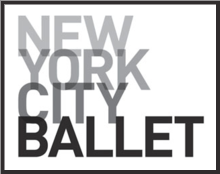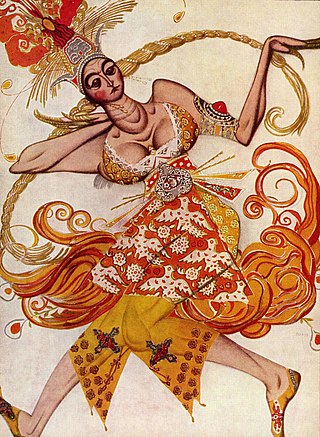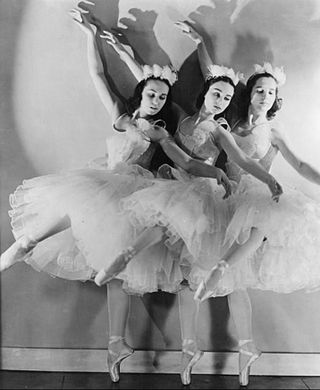Related Research Articles

George Balanchine was an American ballet choreographer of Georgian origin, recognized as one of the most influential choreographers of the 20th-century. Styled as the father of American ballet, he co-founded the New York City Ballet and remained its artistic director for more than 35 years. His choreography is characterized by plotless ballets with minimal costume and décor, performed to classical and neoclassical music.

Mikhail Nikolayevich Baryshnikov is a Latvian and American dancer, choreographer, and actor. He was the preeminent male classical dancer of the 1970s and 1980s. He subsequently became a noted dance director.

New York City Ballet (NYCB) is a ballet company founded in 1948 by choreographer George Balanchine and Lincoln Kirstein. Balanchine and Jerome Robbins are considered the founding choreographers of the company. Léon Barzin was the company's first music director. City Ballet grew out of earlier troupes: the Producing Company of the School of American Ballet, 1934; the American Ballet, 1935, and Ballet Caravan, 1936, which merged into American Ballet Caravan, 1941; and directly from the Ballet Society, 1946.

Bronislava Nijinska was a Russian ballet dancer of Polish origin, and an innovative choreographer. She came of age in a family of traveling, professional dancers.

American Ballet Theatre (ABT) is a classical ballet company based in New York City. Founded in 1939 by Lucia Chase and Richard Pleasant, it is recognized as one of the world's leading classical ballet companies. Through 2019, it had an annual eight-week season at the Metropolitan Opera House in the spring and a shorter season at the David H. Koch Theater in the fall; the company tours around the world the rest of the year. The company was scheduled to have a 5-week spring season at the MET preceded by a 2-week season at the Koch Theater beginning in 2020. ABT is the parent company of the American Ballet Theatre Jacqueline Kennedy Onassis School, and was recognized as "America's National Ballet Company" in 2006 by the United States Congress.

The Firebird is a ballet and orchestral concert work by the Russian composer Igor Stravinsky. It was written for the 1910 Paris season of Sergei Diaghilev's Ballets Russes company; the original choreography was by Michel Fokine, who collaborated with Alexandre Benois and others on a scenario based on the Russian fairy tales of the Firebird and the blessing and curse it possesses for its owner. It was first performed at the Opéra de Paris on 25 June 1910 and was an immediate success, catapulting Stravinsky to international fame and leading to future Diaghilev–Stravinsky collaborations including Petrushka (1911) and The Rite of Spring (1913).

Frederic Franklin, sometimes also called "Freddie", was a British-American ballet dancer, choreographer and director.

Rosella Hightower was an American ballerina and member of the Choctaw Nation. One of the Five Moons, she achieved fame in both the United States and Europe, and later enjoyed a career as an instructor and opera director.
Eliot Feld is an American modern ballet choreographer, performer, teacher, and director. Feld works in contemporary ballet. His company and schools, including the Feld Ballet and Ballet Tech, are involved in dance and dance education in New York City.

The Ballets Russes was an itinerant ballet company begun in Paris that performed between 1909 and 1929 throughout Europe and on tours to North and South America. The company never performed in Russia, where the Revolution disrupted society. After its initial Paris season, the company had no formal ties there.

The company Ballets Russes de Monte-Carlo was formed in 1932 after the death of Sergei Diaghilev and the demise of Ballets Russes. Its director was Wassily de Basil, and its artistic director was René Blum. They fell out in 1936 and the company split. The part which de Basil retained went through two name changes before becoming the Original Ballet Russe. Blum founded Les Ballets de Monte Carlo, which changed its name to Ballet Russe de Monte Carlo when Léonide Massine became artistic director in 1938. It operated under this name until it disbanded some 20 years later.
Helgi Tomasson is an Icelandic choreographer, and a former professional ballet dancer. He served as artistic director and principal choreographer for San Francisco Ballet.
Symphony in C, originally titled Le Palais de Cristal, is a ballet choreographed by George Balanchine, to Georges Bizet's Symphony in C. The ballet was originally created for the Paris Opera Ballet, and premiered on July 28, 1947 at Théâtre National de l'Opéra.
The Original Ballet Russe was a ballet company established in 1931 by René Blum and Colonel Wassily de Basil as a successor to the Ballets Russes, founded in 1909 by Sergei Diaghilev. The company assumed the new name Original Ballet Russe after a split between de Basil and Blum. De Basil led the renamed company, while Blum and others founded a new company under the name Ballet Russe de Monte-Carlo. It was a large scale professional ballet company which toured extensively in Europe, Australia and New Zealand, the United States, and Central and South America. It closed down operations in 1947.
Chaconne is a ballet made by New York City Ballet co-founder and ballet master George Balanchine to ballet music from Gluck's Orfeo ed Euridice. The premiere took place Wednesday, 22 January 1976 at the New York State Theater, Lincoln Center, with lighting by Ronald Bates; Robert Irving conducted. Chaconne was danced in practice clothes at its premiere; Karinska's costumes were added in the spring season.

Who Cares? is a ballet choreographed by George Balanchine to songs by George Gershwin that were orchestrated by Hershy Kay. The ballet is split in two parts, the first danced by an ensemble, and the second focuses on four principal dancers. Who Cares? premiered on February 5, 1970, at the New York State Theater, danced by the New York City Ballet.

Susan Jaffe is an American ballet dancer and arts administrator. She is currently the artistic director of the American Ballet Theatre, where she had danced for 22 years and held the rank of principal dancer. She previously served as the dean of the School of Dance at the University of North Carolina School of the Arts and the artistic director of Pittsburgh Ballet Theatre.

Katharine "Kat" Wildish is a ballerina from Tampa, Florida, U.S. She danced with the New York City Ballet (1981–1983), American Ballet Theatre (1985–1987), and performed as a guest artist for a number of companies worldwide before retiring from stage work in 2007.

Nathalie "Natasha" Krassovska (1918–2005) was a Russian born prima ballerina and teacher of classical ballet most noted for her work with the Ballet Russe de Monte Carlo. Following her decades-long career, she moved to the U.S., where she founded the Krassovska Ballet Jeunesse. Krassovska taught, choreographed and performed until her death.
Stephanie Renee Dabney was an American dancer who performed as a prima ballerina with Dance Theatre of Harlem from 1979 through 1994. Dabney is best known for her performances in John Taras' The Firebird, which she performed all over the world, as well as at the opening ceremony of the 1984 Summer Olympics in Los Angeles.
References
- ↑ McDonaugh, Don (April 23, 2004). "John Taras, Choreographer who spread the ideas of the New York City Ballet". The Guardian.
- ↑ "John Taras, 84; Choreographer and Ballet Master". The Los Angeles Times. April 6, 2004.
- ↑ "John Taras". The Times of London. April 17, 2004.
- ↑ Williams, Alex (March 31, 2024). "Lorraine Graves, Pioneering Harlem Ballerina, Dies at 66 - Tall and commanding, she dazzled audiences as a principal dancer for the groundbreaking Dance Theater of Harlem for nearly two decades". The New York Times . Archived from the original on April 1, 2024. Retrieved April 1, 2024.
- ↑ O'Connor, John (May 5, 1982). "TV: THE HARLEM DANCERS' 'FIREBIRD'". The New York Times.
- ↑ Kriegsman, Alan (July 23, 1984). "ABT Names John Taras Associate Director". The Washington Post.
- ↑ Montee, Kristy (January 30, 1986). "BALLET MASTER TARAS STEPS INTO DUAL ROLE AT ABT". The Sun Sentinel.
- ↑ Pasles, Chris (March 19, 1990). "Associate Artistic Director of ABT Resigns". The Los Angeles Times.
- ↑ Kisselgoff, Anna (April 5, 2004). "John Taras, Choreographer, Is Dead at 84". The New York Times.